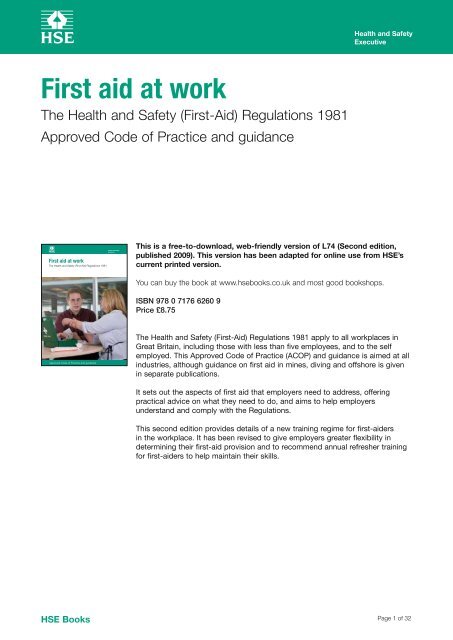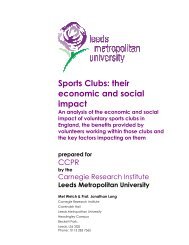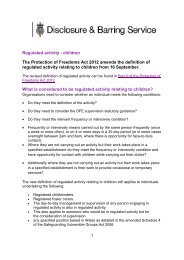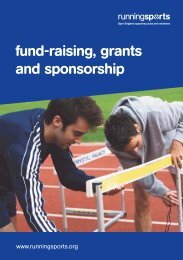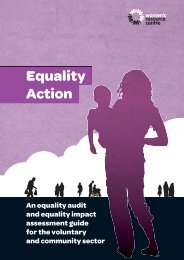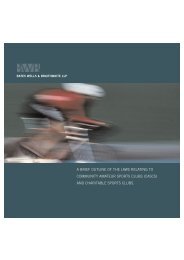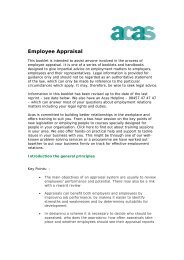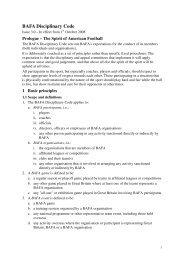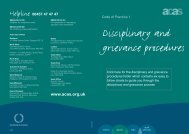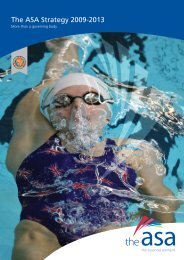First aid at work. The Health and Safety - Sport and Recreation ...
First aid at work. The Health and Safety - Sport and Recreation ...
First aid at work. The Health and Safety - Sport and Recreation ...
- No tags were found...
Create successful ePaper yourself
Turn your PDF publications into a flip-book with our unique Google optimized e-Paper software.
<strong>Health</strong> <strong>and</strong> <strong>Safety</strong>Executive© Crown copyright 2009<strong>First</strong> published 1997Second edition 2009ISBN 978 0 7176 6260 9All rights reserved. No part of this public<strong>at</strong>ion may be reproduced, stored ina retrieval system, or transmitted in any form or by any means (electronic,mechanical, photocopying, recording or otherwise) without the prior writtenpermission of the copyright owner.Applic<strong>at</strong>ions for reproduction should be made in writing to:<strong>The</strong> Office of Public Sector Inform<strong>at</strong>ion, Inform<strong>at</strong>ion Policy Team,Kew, Richmond, Surrey TW9 4DU or e-mail: licensing@opsi.gov.ukApproved Code of PracticeThis Code has been approved by the <strong>Health</strong> <strong>and</strong> <strong>Safety</strong> Commission, with theconsent of the Secretary of St<strong>at</strong>e. It gives practical advice on how to comply withthe law. If you follow the advice you will be doing enough to comply with the lawin respect of those specific m<strong>at</strong>ters on which the Code gives advice. You may usealtern<strong>at</strong>ive methods to those set out in the Code in order to comply with the law.However, the Code has a special legal st<strong>at</strong>us. If you are prosecuted for breach ofhealth <strong>and</strong> safety law, <strong>and</strong> it is proved th<strong>at</strong> you did not follow the relevant provisionsof the Code, you will need to show th<strong>at</strong> you have complied with the law in someother way or a Court will find you <strong>at</strong> fault.<strong>The</strong> Code of Practice in this book was approved in 1997.GuidanceThis guidance is issued by the <strong>Health</strong> <strong>and</strong> <strong>Safety</strong> Executive. Following the guidanceis not compulsory <strong>and</strong> you are free to take other action. But if you do follow theguidance you will normally be doing enough to comply with the law. <strong>Health</strong> <strong>and</strong>safety inspectors seek to secure compliance with the law <strong>and</strong> may refer to thisguidance as illustr<strong>at</strong>ing good practice.Page 2 of 32
<strong>Health</strong> <strong>and</strong> <strong>Safety</strong>ExecutiveContentsNotice of Approval 4Introduction 5Regul<strong>at</strong>ion 1 Cit<strong>at</strong>ion <strong>and</strong> commencement 5Regul<strong>at</strong>ion 2 Interpret<strong>at</strong>ion 5Regul<strong>at</strong>ion 3 Duty of employer to make provision for first-<strong>aid</strong> 6Assessment of need 6<strong>First</strong>-<strong>aid</strong> m<strong>at</strong>erials, equipment <strong>and</strong> facilities 11<strong>First</strong>-<strong>aid</strong> personnel 14Regul<strong>at</strong>ion 4 Duty of employer to inform his employees of the arrangementsmade in connection with first-<strong>aid</strong> 17Inform<strong>at</strong>ion for employees 17Regul<strong>at</strong>ion 5 Duty of self-employed person to provide first-<strong>aid</strong> equipment 17Duties of self-employed persons 17Regul<strong>at</strong>ion 6 Power to grant exemptions 17Regul<strong>at</strong>ion 7 Cases where these Regul<strong>at</strong>ions do not apply 18Regul<strong>at</strong>ion 8 Applic<strong>at</strong>ion to mines 18Regul<strong>at</strong>ion 9 Applic<strong>at</strong>ion offshore 18Regul<strong>at</strong>ion 10 Repeals, revoc<strong>at</strong>ions <strong>and</strong> modific<strong>at</strong>ion 19Schedule 1 Repeals 20Schedule 2 Revoc<strong>at</strong>ions 20Appendix 1 Checklist for assessment of first-<strong>aid</strong> needs 24Appendix 2 Record of first-<strong>aid</strong> provision 26Appendix 3Suggested numbers of first-<strong>aid</strong> personnel to be available <strong>at</strong> all timespeople are <strong>at</strong> <strong>work</strong> 27Appendix 4 Content of a first <strong>aid</strong> <strong>at</strong> <strong>work</strong> course 28Appendix 5 Content of an emergency first <strong>aid</strong> <strong>at</strong> <strong>work</strong> course 29Appendix 6 Content of an annual refresher course 30References <strong>and</strong> further reading 31Further inform<strong>at</strong>ion 32<strong>First</strong> <strong>aid</strong> <strong>at</strong> <strong>work</strong> Page 3 of 32
<strong>Health</strong> <strong>and</strong> <strong>Safety</strong>ExecutiveNotice of ApprovalBy virtue of section 16(4) of the <strong>Health</strong> <strong>and</strong> <strong>Safety</strong> <strong>at</strong> Work etc Act 1974 <strong>and</strong> withthe consent of the Secretary of St<strong>at</strong>e for the Environment, the <strong>Health</strong> <strong>and</strong> <strong>Safety</strong>Commission has on 29 January 1997 approved the revised Code of Practiceentitled <strong>First</strong> Aid <strong>at</strong> Work.<strong>The</strong> revised Approved Code of Practice gives practical guidance with respect to the<strong>Health</strong> <strong>and</strong> <strong>Safety</strong> (<strong>First</strong>-Aid) Regul<strong>at</strong>ions 1981 (SI 1981 No 917).<strong>The</strong> revised Approved Code of Practice comes into effect on 14 March 1997 <strong>and</strong>on th<strong>at</strong> d<strong>at</strong>e the 1990 edition of the Code of Practice shall cease to have effect.SignedT A GATESSecretary to the <strong>Health</strong> <strong>and</strong> <strong>Safety</strong> Commission29 January 1997<strong>The</strong> <strong>Health</strong> <strong>and</strong> <strong>Safety</strong> Commission (HSC) <strong>and</strong> the <strong>Health</strong> <strong>and</strong> <strong>Safety</strong> Executive(HSE) merged on 1 April 2008 to form a single n<strong>at</strong>ional regul<strong>at</strong>ory body. From th<strong>at</strong>d<strong>at</strong>e, the <strong>Health</strong> <strong>and</strong> <strong>Safety</strong> Executive became responsible for approving Codes ofPractice, with the consent of the Secretary of St<strong>at</strong>e.<strong>First</strong> <strong>aid</strong> <strong>at</strong> <strong>work</strong> Page 4 of 32
<strong>Health</strong> <strong>and</strong> <strong>Safety</strong>ExecutiveIntroduction1 <strong>The</strong> <strong>Health</strong> <strong>and</strong> <strong>Safety</strong> (<strong>First</strong>-Aid) Regul<strong>at</strong>ions 1981 set out the essentialaspects of first <strong>aid</strong> th<strong>at</strong> employers have to address. This public<strong>at</strong>ion will helpemployers to underst<strong>and</strong> <strong>and</strong> comply with the Regul<strong>at</strong>ions. It offers practicaladvice on wh<strong>at</strong> employers need to do. Employers may also find it useful to look <strong>at</strong>HSE’s ‘<strong>First</strong> <strong>aid</strong> <strong>at</strong> <strong>work</strong>’ website (see ‘Further inform<strong>at</strong>ion’). Practical guidance onfirst <strong>aid</strong> in mines is given in a separ<strong>at</strong>e public<strong>at</strong>ion (see ‘Further reading’). <strong>The</strong>seRegul<strong>at</strong>ions apply to all <strong>work</strong>places, including those with less than five employees,<strong>and</strong> to the self-employed.2 This public<strong>at</strong>ion contains the Regul<strong>at</strong>ions, Approved Code of Practice <strong>and</strong>guidance. <strong>The</strong> regul<strong>at</strong>ions are shown in italics, the Code of Practice is shown inbold, <strong>and</strong> the guidance on regul<strong>at</strong>ions is in plain text.Regul<strong>at</strong>ion1Regul<strong>at</strong>ion 1 Cit<strong>at</strong>ion <strong>and</strong> commencement<strong>The</strong>se Regul<strong>at</strong>ions may be cited as the <strong>Health</strong> <strong>and</strong> <strong>Safety</strong> (<strong>First</strong>-Aid) Regul<strong>at</strong>ions1981 <strong>and</strong> shall come into oper<strong>at</strong>ion on 1st July 1982.Regul<strong>at</strong>ionRegul<strong>at</strong>ion 2 Interpret<strong>at</strong>ion(1) In these Regul<strong>at</strong>ions, unless the context otherwise requires –“first-<strong>aid</strong>” means –(a)(b)in cases where a person will need help from a medical practitioner ornurse, tre<strong>at</strong>ment for the purpose of preserving life <strong>and</strong> minimising theconsequences of injury <strong>and</strong> illness until such help is obtained, <strong>and</strong>tre<strong>at</strong>ment of minor injuries which would otherwise receive no tre<strong>at</strong>mentor which do not need tre<strong>at</strong>ment by a medical practitioner or nurse;“mine” means a mine within the meaning of Section 180 of the Mines <strong>and</strong>Quarries Act 1954 (a) .(2) In these Regul<strong>at</strong>ions, unless the context otherwise requires, anyreference to –(a)(b)a numbered Regul<strong>at</strong>ion or Schedule is a reference to the Regul<strong>at</strong>ion of,or Schedule to, these Regul<strong>at</strong>ions bearing th<strong>at</strong> number;a numbered paragraph is a reference to the paragraph bearing th<strong>at</strong>number in the Regul<strong>at</strong>ion in which the reference appears.2Guidance2(a) 1954 c.70; relevant amending instrument is SI 1974/2013.3 Employers have a legal duty to make arrangements to ensure their employeesreceive immedi<strong>at</strong>e <strong>at</strong>tention if they are injured or taken ill <strong>at</strong> <strong>work</strong>. It doesn’t m<strong>at</strong>terwhether the injury or illness is caused by the <strong>work</strong> they do. Wh<strong>at</strong> is important isth<strong>at</strong> they receive immedi<strong>at</strong>e <strong>at</strong>tention <strong>and</strong> th<strong>at</strong> an ambulance is called in seriouscases. <strong>First</strong> <strong>aid</strong> can save lives <strong>and</strong> prevent minor injuries becoming major ones.<strong>First</strong> <strong>aid</strong> <strong>at</strong> <strong>work</strong> covers the arrangements th<strong>at</strong> need to be made to manage injuriesor illness suffered <strong>at</strong> <strong>work</strong>. <strong>The</strong> Regul<strong>at</strong>ions do not prevent staff, who are speciallytrained, from taking action beyond the initial management stage.<strong>First</strong> <strong>aid</strong> <strong>at</strong> <strong>work</strong> Page 5 of 32
<strong>Health</strong> <strong>and</strong> <strong>Safety</strong>ExecutiveRegul<strong>at</strong>ionRegul<strong>at</strong>ion 3 Duty of employer to make provision forfirst-<strong>aid</strong>(1) An employer shall provide, or ensure th<strong>at</strong> there are provided, suchequipment <strong>and</strong> facilities as are adequ<strong>at</strong>e <strong>and</strong> appropri<strong>at</strong>e in the circumstances forenabling first-<strong>aid</strong> to be rendered to his employees if they are injured or become ill <strong>at</strong><strong>work</strong>.(2) Subject to paragraphs (3) <strong>and</strong> (4), an employer shall provide, or ensureth<strong>at</strong> there is provided, such number of suitable persons as is adequ<strong>at</strong>e <strong>and</strong>appropri<strong>at</strong>e in the circumstances for rendering first-<strong>aid</strong> to his employees if they areinjured or become ill <strong>at</strong> <strong>work</strong>; <strong>and</strong> for this purpose a person shall not be suitableunless he has undergone –(a)(b)such training <strong>and</strong> has such qualific<strong>at</strong>ions as the <strong>Health</strong> <strong>and</strong> <strong>Safety</strong>Executive may approve for the time being in respect of th<strong>at</strong> case or classof case, <strong>and</strong>such additional training, if any, as may be appropri<strong>at</strong>e in thecircumstances of th<strong>at</strong> case.(3) Where a person provided under paragraph (2) is absent in temporary<strong>and</strong> exceptional circumstances it shall be sufficient compliance with th<strong>at</strong> paragraphif the employer appoints a person, or ensures th<strong>at</strong> a person is appointed, to takecharge of –(a) the situ<strong>at</strong>ion rel<strong>at</strong>ing to an injured or ill employee who will need help froma medical practitioner or nurse, <strong>and</strong>(b) the equipment <strong>and</strong> facilities provided under paragraph (1)throughout the period of any such absence.(4) Where having regard to –(a)(b)(c)the n<strong>at</strong>ure of the undertaking, <strong>and</strong>the number of employees <strong>at</strong> <strong>work</strong>, <strong>and</strong>the loc<strong>at</strong>ion of the establishment,3it would be adequ<strong>at</strong>e <strong>and</strong> appropri<strong>at</strong>e if instead of a person for rendering first-<strong>aid</strong>there was a person appointed to take charge as in paragraph (3) (a) <strong>and</strong> (b), theninstead of complying with paragraph (2) the employer may appoint such a person,or ensure th<strong>at</strong> such a person is appointed.ACOP3GuidanceAssessment of need4 An employer should make an assessment of first-<strong>aid</strong> needsappropri<strong>at</strong>e to the circumstances of each <strong>work</strong>place.5 <strong>The</strong> aim of first <strong>aid</strong> is to reduce the effects of injury or illness suffered <strong>at</strong> <strong>work</strong>,whether caused by the <strong>work</strong> itself or not. <strong>First</strong>-<strong>aid</strong> provision must be ‘adequ<strong>at</strong>e <strong>and</strong>appropri<strong>at</strong>e in the circumstances’. This means th<strong>at</strong> sufficient first-<strong>aid</strong> equipment,facilities <strong>and</strong> personnel should be available:3(a)(b)to give immedi<strong>at</strong>e assistance to casualties with both common injuries orillness <strong>and</strong> those likely to arise from specific hazards <strong>at</strong> <strong>work</strong>;to summon an ambulance or other professional help.<strong>First</strong> <strong>aid</strong> <strong>at</strong> <strong>work</strong> Page 6 of 32
<strong>Health</strong> <strong>and</strong> <strong>Safety</strong>ExecutiveGuidance6 Where an employer provides first-<strong>aid</strong>ers in the <strong>work</strong>place, they should havea valid certific<strong>at</strong>e of competence in either first <strong>aid</strong> <strong>at</strong> <strong>work</strong> (FAW) or emergency first<strong>aid</strong> <strong>at</strong> <strong>work</strong> (EFAW). EFAW training enables a first-<strong>aid</strong>er to give emergency first<strong>aid</strong> to someone who is injured or becomes ill while <strong>at</strong> <strong>work</strong>. FAW training includesEFAW <strong>and</strong> also equips the first-<strong>aid</strong>er to apply first <strong>aid</strong> to a range of specific injuries<strong>and</strong> illness (see paragraphs 52–66).7 If an employer decides a first-<strong>aid</strong>er is not required in the <strong>work</strong>place, a personshould be appointed to take charge of the first-<strong>aid</strong> arrangements. <strong>The</strong> role of thisappointed person includes looking after the first-<strong>aid</strong> equipment <strong>and</strong> facilities <strong>and</strong>calling the emergency services when required. <strong>The</strong>y can also provide emergencycover where a first-<strong>aid</strong>er is absent due to unforeseen circumstances (seeparagraphs 67–70).8 How much first-<strong>aid</strong> provision an employer has to make depends on thecircumstances of each <strong>work</strong>place. <strong>The</strong>re is no fixed level but each employerneeds to assess wh<strong>at</strong> equipment, facilities <strong>and</strong> personnel are appropri<strong>at</strong>e. Whereemployers have an occup<strong>at</strong>ional health service or access to other occup<strong>at</strong>ionalhealth advice, they might wish to deleg<strong>at</strong>e to them the responsibility for carrying outthe assessment <strong>and</strong> advising on first-<strong>aid</strong> provision.9 <strong>The</strong>re is no requirement for the assessment of first-<strong>aid</strong> needs to be formalor written down although it may be useful for employers to record the results.Employers might need to justify their level of first-<strong>aid</strong> provision.10 In assessing their needs, employers should consider:(a)(b)(c)(d)(e)(f)(g)(h)(i)(j)(k)the n<strong>at</strong>ure of the <strong>work</strong> <strong>and</strong> <strong>work</strong>place hazards <strong>and</strong> risks;the size of the organis<strong>at</strong>ion;the n<strong>at</strong>ure of the <strong>work</strong>force;the organis<strong>at</strong>ion’s history of accidents;the needs of travelling, remote <strong>and</strong> lone <strong>work</strong>ers;<strong>work</strong> p<strong>at</strong>terns;the distribution of the <strong>work</strong>force;the remoteness of the site from emergency medical services;employees <strong>work</strong>ing on shared or multi-occupied sites;annual leave <strong>and</strong> other absences of first-<strong>aid</strong>ers <strong>and</strong> appointed persons;first-<strong>aid</strong> provision for non-employees.11 Appendix 1 contains a checklist to help employers assess their needs <strong>and</strong>record relevant inform<strong>at</strong>ion. Appendix 2 can act as a record of first-<strong>aid</strong> provision.N<strong>at</strong>ure of the <strong>work</strong>12 <strong>The</strong> Management of <strong>Health</strong> <strong>and</strong> <strong>Safety</strong> <strong>at</strong> Work Regul<strong>at</strong>ions 1999 requireemployers to make an assessment of the risks to health <strong>and</strong> safety of theiremployees <strong>at</strong> <strong>work</strong>, to identify wh<strong>at</strong> measures they need to take to prevent orcontrol these risks. 1,2 Inform<strong>at</strong>ion g<strong>at</strong>hered from the risk assessment can help theemployer carry out their assessment of first-<strong>aid</strong> needs, if preventive or controlmeasures fail. Identifying the likely n<strong>at</strong>ure of an accident or injury will help theemployer <strong>work</strong> out the type, quantity <strong>and</strong> loc<strong>at</strong>ion of first-<strong>aid</strong> equipment, facilities<strong>and</strong> personnel to provide.313 To help employers, Table 1 gives examples of a number of hazards commonlyfound in the <strong>work</strong>place, the causes of accidents th<strong>at</strong> might occur in <strong>work</strong>ing withthem <strong>and</strong> the injuries th<strong>at</strong> might arise. It is not intended to cover all hazards th<strong>at</strong>may be present in the <strong>work</strong>place or all injuries th<strong>at</strong> might occur. It should also beremembered th<strong>at</strong> an employee might become ill <strong>at</strong> any time. An assessment of<strong>First</strong> <strong>aid</strong> <strong>at</strong> <strong>work</strong> Page 7 of 32
<strong>Health</strong> <strong>and</strong> <strong>Safety</strong>ExecutiveGuidancefirst-<strong>aid</strong> needs should consider this possibility, whether or not an illness is causedby <strong>work</strong>. More detailed inform<strong>at</strong>ion on <strong>work</strong>place hazards, risk assessment <strong>and</strong>how to prevent <strong>work</strong>-rel<strong>at</strong>ed injuries <strong>and</strong> illness is available on HSE’s website (see‘Further inform<strong>at</strong>ion’).Table 1 Hazards commonly found in the <strong>work</strong>placeHazard Causes of accidents Examples of injuryrequiring first <strong>aid</strong>ChemicalsElectricityMachineryManualh<strong>and</strong>lingSlip <strong>and</strong> triphazardsWork <strong>at</strong>heightWorkplacetransportExposure during h<strong>and</strong>ling; spillages; splashing;leaksFailure to securely isol<strong>at</strong>e electrical systems<strong>and</strong> equipment during <strong>work</strong> on them; poorlymaintained electrical equipment; contact withoverhead power lines, underground powercables or mains electricity supplies; usingunsuitable electrical equipment in explosive<strong>at</strong>mospheresLoose hair or clothing becoming tangledin machinery; being hit by moving parts orm<strong>at</strong>erial thrown from machinery; contact withsharp edgesRepetitive <strong>and</strong>/or heavy lifting, bending<strong>and</strong> twisting; exerting too much force;h<strong>and</strong>ling bulky or unstable loads; h<strong>and</strong>ling inuncomfortable <strong>work</strong>ing positionsUneven floors; trailing cables; obstructions;slippery surfaces due to spillages; worn carpets<strong>and</strong> m<strong>at</strong>sOverreaching or overbalancing when usingladders; falling off or through a roofHit by, hit against or falling from a vehicle;being hit by part of a load falling from a vehicle;being injured as a result of a vehicle collapse oroverturnPoisoning, loss ofconsciousness,burns, eye injuriesElectric shock, burnsCrush injuries,amput<strong>at</strong>ions,fractures, lacer<strong>at</strong>ions,eye injuriesFractures,lacer<strong>at</strong>ions, sprains<strong>and</strong> strainsFractures,lacer<strong>at</strong>ions, sprains<strong>and</strong> strainsHead injury, loss ofconsciousness, spinalinjury, fractures,sprains <strong>and</strong> strainsCrush injuries, headinjury, fractures,sprains <strong>and</strong> strains14 <strong>The</strong> type of <strong>work</strong> performed will help determine the identifiable hazards in the<strong>work</strong>place <strong>and</strong> the possible harmful consequences for employees, <strong>and</strong> thereforethe level of first-<strong>aid</strong> provision. For example, in organis<strong>at</strong>ions such as offices orshops, employers may only need to provide an appointed person to take chargeof first-<strong>aid</strong> arrangements, <strong>and</strong> a clearly identified <strong>and</strong> suitably stocked first-<strong>aid</strong> box.However, even in these circumstances it is still possible for an accident or suddenillness to occur <strong>and</strong> employers may wish to consider having a qualified first-<strong>aid</strong>eravailable.15 Where the <strong>work</strong> involves hazards such as chemicals or dangerous machinery,or special hazards such as hydrofluoric acid or confined spaces, first-<strong>aid</strong>requirements will be gre<strong>at</strong>er. Employers may then need to:3(a)(b)(c)provide a sufficient number of qualified first-<strong>aid</strong>ers so th<strong>at</strong> someone is alwaysavailable to give first <strong>aid</strong> immedi<strong>at</strong>ely following an incident;provide additional training for first-<strong>aid</strong>ers to deal with injuries resulting fromspecial hazards;consider additional first-<strong>aid</strong> equipment;<strong>First</strong> <strong>aid</strong> <strong>at</strong> <strong>work</strong> Page 8 of 32
<strong>Health</strong> <strong>and</strong> <strong>Safety</strong>ExecutiveGuidance(d)(e)provide one or more first-<strong>aid</strong> rooms;inform the local emergency services, in writing, of the site where hazardoussubstances or processes are in use.16 In deciding on their first-<strong>aid</strong> provision, employers will need to take account ofdifferent <strong>work</strong> activities in different parts of an establishment. For example, a <strong>work</strong>site may contain production <strong>and</strong> office/administr<strong>at</strong>ion areas. In such circumstances,it is likely th<strong>at</strong> separ<strong>at</strong>e risk assessments will have to be made for individualdepartments, <strong>and</strong> the results of these should be carried over to the assessmentof first-<strong>aid</strong> needs. This will mean th<strong>at</strong> first-<strong>aid</strong> provision could vary betweendepartments or buildings.Size of the organis<strong>at</strong>ion17 Generally, the larger the <strong>work</strong>force, the gre<strong>at</strong>er the first-<strong>aid</strong> provision th<strong>at</strong> isrequired. However, employee numbers should not be the sole basis for determiningfirst-<strong>aid</strong> needs. A gre<strong>at</strong>er level of provision may be required when fewer people are<strong>at</strong> <strong>work</strong> but are undertaking tasks such as maintenance <strong>work</strong>. Employers shouldprovide sufficient cover for the various circumstances th<strong>at</strong> can occur.18 Even in <strong>work</strong>places with a small number of employees there is still thepossibility of an accident or sudden illness. <strong>The</strong>refore, employers may wish toconsider providing a qualified first-<strong>aid</strong>er.N<strong>at</strong>ure of the <strong>work</strong>force19 <strong>The</strong> particular needs of young <strong>work</strong>ers, trainees, pregnant <strong>work</strong>ers <strong>and</strong>employees with disabilities or particular health problems should be addressed.<strong>First</strong>-<strong>aid</strong> provision should also be extended to <strong>work</strong> experience trainees.History of accidents20 Inform<strong>at</strong>ion collected when investig<strong>at</strong>ing previous accidents/incidents shouldbe used when assessing the adequacy of future first-<strong>aid</strong> provision. For large <strong>and</strong>/ormulti-site organis<strong>at</strong>ions this inform<strong>at</strong>ion could be helpful in determining where first<strong>aid</strong>ersshould be loc<strong>at</strong>ed, wh<strong>at</strong> geographical area they should be required to cover<strong>and</strong> wh<strong>at</strong> first-<strong>aid</strong> equipment is necessary.Needs of travelling, remote <strong>and</strong> lone <strong>work</strong>ers21 Employers are responsible for meeting the first-<strong>aid</strong> needs of their employees<strong>work</strong>ing away from the main site, for example those who travel regularly or who<strong>work</strong> elsewhere. <strong>The</strong> assessment should determine whether those who travellong distances or are continuously mobile should carry a personal first-<strong>aid</strong> kit.Organis<strong>at</strong>ions with employees who <strong>work</strong> in remote areas should consider makingspecial arrangements such as issuing personal communic<strong>at</strong>ors <strong>and</strong> providingadditional training. Where employees <strong>work</strong> alone, other means of summoning help,such as a mobile phone, may be useful to call for assistance in an emergency.Work p<strong>at</strong>terns322 <strong>First</strong>-<strong>aid</strong> requirements may vary where employees <strong>work</strong> shifts or out of hours.It is important th<strong>at</strong> sufficient provision is always available when employees are <strong>at</strong><strong>work</strong>, <strong>and</strong> separ<strong>at</strong>e arrangements may have to be made for each shift.<strong>First</strong> <strong>aid</strong> <strong>at</strong> <strong>work</strong> Page 9 of 32
<strong>Health</strong> <strong>and</strong> <strong>Safety</strong>ExecutiveGuidanceDistribution of the <strong>work</strong>force23 An employer should consider how the size of the premises could affect quickaccess to first-<strong>aid</strong> facilities. For example, whether additional first-<strong>aid</strong> provision isneeded on a site with more than one building, or whether the distance betweenbuildings is such th<strong>at</strong> additional provision would be unnecessary. Employers with amulti-floor building should consider how many first-<strong>aid</strong>ers or appointed persons willbe required to give adequ<strong>at</strong>e provision to employees on each floor. Consider<strong>at</strong>ionshould also be given to employees who <strong>work</strong> in self-contained areas, <strong>and</strong> how theirneeds are assessed <strong>and</strong> met.Remoteness of the site from emergency medical services24 Where a site is remote from emergency medical services, employers mayneed to make special arrangements to ensure appropri<strong>at</strong>e transport is available.Employers should inform the emergency services, in writing, of their loc<strong>at</strong>ion <strong>and</strong>any particular circumstances, including specific hazards.Employees <strong>work</strong>ing on shared or multi-occupied sites25 On a shared or multi-occupied site, employers can arrange for one employerto take responsibility for providing first-<strong>aid</strong> cover for all the <strong>work</strong>ers. In thesecases, a full exchange of inform<strong>at</strong>ion about the hazards <strong>and</strong> risks involved shouldhelp ensure th<strong>at</strong> the shared provision is adequ<strong>at</strong>e. All employers should agreethe arrangements <strong>and</strong> employees should be kept informed. A written agreementbetween employers is strongly recommended to avoid any misunderst<strong>and</strong>ings.26 Where an employment business contracts out employees to anotheremployer, the employment business should ensure, by arrangement with the useremployer, th<strong>at</strong> these employees have access to first-<strong>aid</strong> provision.Annual leave <strong>and</strong> other absences of first-<strong>aid</strong>ers <strong>and</strong> appointed persons27 It is essential th<strong>at</strong> adequ<strong>at</strong>e provision is made <strong>at</strong> all times people are <strong>at</strong> <strong>work</strong>.Employers therefore need to ensure there is cover for annual leave <strong>and</strong> otherplanned absences of first-<strong>aid</strong>ers or appointed persons. Employers should alsoconsider wh<strong>at</strong> cover is needed for unplanned <strong>and</strong> exceptional absences such assick leave or special leave due to bereavement.<strong>First</strong>-<strong>aid</strong> provision for non-employees28 <strong>The</strong>se Regul<strong>at</strong>ions do not require employers to provide first <strong>aid</strong> for anyoneother than their own employees. However, many organis<strong>at</strong>ions such as schools,places of entertainment, fairgrounds <strong>and</strong> shops provide a service for others <strong>and</strong> it isstrongly recommended th<strong>at</strong> employers include non-employees in their assessmentof first-<strong>aid</strong> needs <strong>and</strong> make provision for them.29 Where first-<strong>aid</strong> provision is intended to cover both employees <strong>and</strong> nonemployees,employers should check their liability insurance covers all the activitiesof first-<strong>aid</strong>ers. <strong>The</strong>y should also ensure th<strong>at</strong>:3(a)(b)the level of provision for employees does not fall below the st<strong>and</strong>ard requiredby these Regul<strong>at</strong>ions;the level of provision for non-employees complies with any other relevantlegisl<strong>at</strong>ion <strong>and</strong> guidance.<strong>First</strong> <strong>aid</strong> <strong>at</strong> <strong>work</strong> Page 10 of 32
<strong>Health</strong> <strong>and</strong> <strong>Safety</strong>ExecutiveGuidanceReview of first-<strong>aid</strong> provision30 Employers should periodically review their first-<strong>aid</strong> needs, particularly afterany oper<strong>at</strong>ing changes, to ensure provision remains appropri<strong>at</strong>e. To help with thisprocess, it is recommended th<strong>at</strong> a record is kept of the incidents dealt with by first<strong>aid</strong>ers<strong>and</strong> appointed persons (see paragraphs 31–32).Records31 It is good practice for employers to provide first-<strong>aid</strong>ers <strong>and</strong> appointed personswith a book in which to record incidents they <strong>at</strong>tend. Any such book should bekept in accordance with the requirements of the D<strong>at</strong>a Protection Act 1998 (see‘Further reading’). Where there are a number of first-<strong>aid</strong>ers <strong>work</strong>ing for a singleemployer, it would be advisable for one central book to be used, though this maynot be practicable on larger, well spread out sites. <strong>The</strong> inform<strong>at</strong>ion to be recordedshould include:(a)(b)(c)(d)(e)d<strong>at</strong>e, time <strong>and</strong> place of the incident;name <strong>and</strong> job of the injured or ill person;details of the injury/illness <strong>and</strong> wh<strong>at</strong> first <strong>aid</strong> was given;wh<strong>at</strong> happened to the person immedi<strong>at</strong>ely afterwards (for example went backto <strong>work</strong>, went home, went to hospital);name <strong>and</strong> sign<strong>at</strong>ure of the first-<strong>aid</strong>er or person dealing with the incident.32 This inform<strong>at</strong>ion can help the employer identify accident trends <strong>and</strong> possibleareas for improvement in the control of health <strong>and</strong> safety risks. It can be usedfor reference in future first-<strong>aid</strong> needs assessments. <strong>The</strong>se records may also behelpful for insurance <strong>and</strong> investig<strong>at</strong>ive purposes. <strong>The</strong> record book is not the sameas the st<strong>at</strong>utory accident book (see ‘Further reading’), although the two might becombined.RIDDOR3ACOP33 Employers, self-employed people <strong>and</strong> those in control of premises have aduty to report some accidents <strong>and</strong> incidents <strong>at</strong> <strong>work</strong> under RIDDOR (Reporting ofInjuries, Diseases <strong>and</strong> Dangerous Occurrences Regul<strong>at</strong>ions 1995). 3,4 You can reportan incident quickly, easily <strong>and</strong> in confidence using the telephone number <strong>and</strong> onlinecontacts given in ‘Further inform<strong>at</strong>ion’.<strong>First</strong> <strong>aid</strong> m<strong>at</strong>erials, equipment <strong>and</strong> facilities34 When the assessment of first-<strong>aid</strong> requirements has been completed,the employer should provide the m<strong>at</strong>erials, equipment <strong>and</strong> facilities neededto ensure th<strong>at</strong> the level of cover identified as necessary will be availableto employees <strong>at</strong> all relevant times. This will include ensuring th<strong>at</strong> first-<strong>aid</strong>equipment, suitably marked <strong>and</strong> easily accessible, is available in all placeswhere <strong>work</strong>ing conditions require it.<strong>First</strong>-<strong>aid</strong> containers3Guidance335 <strong>The</strong> minimum level of first-<strong>aid</strong> equipment is a suitably stocked <strong>and</strong>properly identified first-<strong>aid</strong> container. Every employer should provide foreach <strong>work</strong> site <strong>at</strong> least one first-<strong>aid</strong> container supplied with a sufficientquantity of first-<strong>aid</strong> m<strong>at</strong>erials suitable for the particular circumstances.36 Depending on the findings of the first-<strong>aid</strong> needs assessment, more than onefirst-<strong>aid</strong> container might be required on large sites. <strong>First</strong>-<strong>aid</strong> containers should beeasily accessible <strong>and</strong> preferably placed near to h<strong>and</strong> washing facilities. <strong>The</strong>y should<strong>First</strong> <strong>aid</strong> <strong>at</strong> <strong>work</strong> Page 11 of 32
<strong>Health</strong> <strong>and</strong> <strong>Safety</strong>ExecutiveGuidanceonly be stocked with items useful for giving first <strong>aid</strong> <strong>and</strong> should protect them fromdust <strong>and</strong> damp. All first-<strong>aid</strong> containers should be identified by a white cross on agreen background. 537 <strong>The</strong>re is no m<strong>and</strong><strong>at</strong>ory list of items to be included in a first-<strong>aid</strong>container. <strong>The</strong> decision on wh<strong>at</strong> to provide will be influenced by the findings of thefirst-<strong>aid</strong> needs assessment. As a guide, where <strong>work</strong> activities involve low hazards, aminimum stock of first-<strong>aid</strong> items might be:(a) a leaflet giving general guidance on first <strong>aid</strong> (for example, HSE’s leaflet Basicadvice on first <strong>aid</strong> <strong>at</strong> <strong>work</strong> 6 );(b) 20 individually wrapped sterile plasters (assorted sizes), appropri<strong>at</strong>e to thetype of <strong>work</strong> (hypoallergenic plasters can be provided, if necessary);(c) two sterile eye pads;(d) four individually wrapped triangular b<strong>and</strong>ages, preferably sterile;(e) six safety pins;(f) two large sterile individually wrapped unmedic<strong>at</strong>ed wound dressings;(g) six medium-sized individually wrapped unmedic<strong>at</strong>ed wound dressings;(h) a pair of disposable gloves (see HSE’s leaflet L<strong>at</strong>ex <strong>and</strong> you 7 ).This is a suggested contents list only.38 <strong>The</strong> contents of first-<strong>aid</strong> containers should be examined frequently <strong>and</strong>restocked soon after use. Sufficient supplies should be held in stock on site. Careshould be taken to dispose of items safely once they reach their expiry d<strong>at</strong>e.Additional first-<strong>aid</strong> m<strong>at</strong>erials <strong>and</strong> equipment39 <strong>The</strong> needs assessment may indic<strong>at</strong>e th<strong>at</strong> additional m<strong>at</strong>erials <strong>and</strong> equipmentare required, for example scissors, adhesive tape, disposable aprons <strong>and</strong>individually wrapped moist wipes. <strong>The</strong>y may be kept in the first-<strong>aid</strong> container ifthere is room or stored separ<strong>at</strong>ely.40 If mains tap w<strong>at</strong>er is not readily available for eye irrig<strong>at</strong>ion, <strong>at</strong> least a litre ofsterile w<strong>at</strong>er or sterile normal saline (0.9%) in sealed, disposable containers shouldbe provided. Once the seal has been broken, containers should not be kept forreuse. Containers should not be used beyond their expiry d<strong>at</strong>e.41 <strong>The</strong>re may be a need for items such as protective equipment in case first<strong>aid</strong>ershave to enter dangerous <strong>at</strong>mospheres, or blankets to protect casualties fromthe elements. Such items should be stored securely near the first-<strong>aid</strong> container, inthe first-<strong>aid</strong> room or in the hazard area, as appropri<strong>at</strong>e. Access to them should berestricted to people trained in their use.Tablets <strong>and</strong> medic<strong>at</strong>ion42 <strong>First</strong> <strong>aid</strong> <strong>at</strong> <strong>work</strong> does not include giving tablets or medicines to tre<strong>at</strong> illness.<strong>The</strong> only exception to this is where aspirin is used when giving first <strong>aid</strong> to a casualtywith a suspected heart <strong>at</strong>tack in accordance with currently accepted first-<strong>aid</strong>practice. 8 It is recommended th<strong>at</strong> tablets <strong>and</strong> medicines should not be kept in thefirst-<strong>aid</strong> container.343 Some <strong>work</strong>ers carry their own medic<strong>at</strong>ion th<strong>at</strong> has been prescribed by theirdoctor (eg an inhaler for asthma). If an individual needs to take their own prescribedmedic<strong>at</strong>ion, the first-<strong>aid</strong>er’s role is generally limited to helping them do so <strong>and</strong>contacting the emergency services as appropri<strong>at</strong>e.<strong>First</strong> <strong>aid</strong> <strong>at</strong> <strong>work</strong> Page 12 of 32
<strong>Health</strong> <strong>and</strong> <strong>Safety</strong>ExecutiveGuidanceAutom<strong>at</strong>ed external defibrill<strong>at</strong>ors44 Where an employer decides to provide a defibrill<strong>at</strong>or in the <strong>work</strong>place, itis important th<strong>at</strong> those who may use it are appropri<strong>at</strong>ely trained (see ‘Furtherinform<strong>at</strong>ion’). HSE does not specify the content of this training <strong>and</strong> organis<strong>at</strong>ionsproviding it do not need HSE approval.Travelling first-<strong>aid</strong> kits45 <strong>The</strong>re is no m<strong>and</strong><strong>at</strong>ory list of items to be included in first-<strong>aid</strong> kits fortravelling <strong>work</strong>ers. <strong>The</strong>y might typically contain:(a) a leaflet giving general guidance on first <strong>aid</strong> (for example HSE’s leaflet Basicadvice on first <strong>aid</strong> <strong>at</strong> <strong>work</strong> 6 );(b) six individually wrapped sterile plasters (hypoallergenic plasters can beprovided, if necessary);(c) two triangular b<strong>and</strong>ages;(d) two safety pins;(e) one large sterile unmedic<strong>at</strong>ed dressing;(f) individually wrapped moist cleansing wipes;(g) a pair of disposable gloves (see HSE’s leaflet L<strong>at</strong>ex <strong>and</strong> you 7 ).3ACOP3GuidanceThis is a suggested contents list only.46 Suitable arrangements should be in place for restocking kits.<strong>First</strong>-<strong>aid</strong> rooms47 Employers should provide a suitable first-<strong>aid</strong> room or rooms wherethe assessment of first-<strong>aid</strong> needs identifies this as necessary. <strong>The</strong> first<strong>aid</strong>room(s) should contain essential first-<strong>aid</strong> facilities <strong>and</strong> equipment, beeasily accessible to stretchers <strong>and</strong> be clearly signposted <strong>and</strong> identified. Ifpossible, the room(s) should be reserved exclusively for giving first <strong>aid</strong>.48 A first-<strong>aid</strong> room will usually be necessary where there are higher hazards suchas in chemical industries or on large construction sites, <strong>and</strong> in larger premises <strong>at</strong> adistance from medical services. A design<strong>at</strong>ed person should be given responsibilityfor supervising it. <strong>The</strong> room(s) should be clearly signposted <strong>and</strong> identified by whitelettering or symbols on a green background. 549 <strong>First</strong>-<strong>aid</strong> rooms should:(a)(b)(c)(d)(e)be large enough to hold an examin<strong>at</strong>ion/medical couch, with enough space <strong>at</strong>each side for people to <strong>work</strong>, a chair <strong>and</strong> any necessary additional equipment;have washable surfaces <strong>and</strong> adequ<strong>at</strong>e he<strong>at</strong>ing, ventil<strong>at</strong>ion, <strong>and</strong> lighting;be kept clean, tidy, accessible <strong>and</strong> available for use <strong>at</strong> all times whenemployees are <strong>at</strong> <strong>work</strong>;be positioned as near as possible to a point of access for transport tohospital;display a notice on the door advising of the names, loc<strong>at</strong>ions, <strong>and</strong> ifappropri<strong>at</strong>e, telephone extensions of first-<strong>aid</strong>ers <strong>and</strong> how to contact them.50 Typical examples of the equipment <strong>and</strong> facilities a first-<strong>aid</strong> room may containare:3(a)(b)(c)a sink with hot <strong>and</strong> cold running w<strong>at</strong>er;drinking w<strong>at</strong>er with disposable cups;soap <strong>and</strong> paper towels;<strong>First</strong> <strong>aid</strong> <strong>at</strong> <strong>work</strong> Page 13 of 32
<strong>Health</strong> <strong>and</strong> <strong>Safety</strong>ExecutiveGuidance(d)(e)(f)(g)(h)(i)a store for first-<strong>aid</strong> m<strong>at</strong>erials;foot-oper<strong>at</strong>ed refuse containers, lined with disposable yellow clinical wastebags or a container suitable for the safe disposal of clinical waste;an examin<strong>at</strong>ion/medical couch with w<strong>at</strong>erproof protection <strong>and</strong> clean pillows<strong>and</strong> blankets (a paper couch roll may be used th<strong>at</strong> is changed betweencasualties);a chair;a telephone or other communic<strong>at</strong>ion equipment;a record book for recording incidents <strong>at</strong>tended by a first-<strong>aid</strong>er or appointedperson (see paragraphs 31–32).51 If the first-<strong>aid</strong> room(s) cannot be reserved exclusively for giving first <strong>aid</strong>,employers need to make sure th<strong>at</strong> the first-<strong>aid</strong> facilities can be made availablequickly if necessary. For example, they should consider the implic<strong>at</strong>ions of whether:3(a)(b)(c)the activities usually carried out in the room can be stopped immedi<strong>at</strong>ely in anemergency;the furnishings <strong>and</strong> equipment can be moved easily <strong>and</strong> quickly to a positionth<strong>at</strong> will not interfere with giving first <strong>aid</strong>;the storage arrangements for first-<strong>aid</strong> furnishings <strong>and</strong> equipment allow themto be made available quickly when necessary.ACOP<strong>First</strong>-<strong>aid</strong> personnel<strong>First</strong>-<strong>aid</strong>ers3Guidance52 Where the first-<strong>aid</strong> assessment identifies a need for people to beavailable for rendering first <strong>aid</strong>, the employer should ensure th<strong>at</strong> they areprovided in sufficient numbers <strong>and</strong> <strong>at</strong> appropri<strong>at</strong>e loc<strong>at</strong>ions to enable first<strong>aid</strong> to be administered without delay should the occasion arise. Where 50or more people are employed, <strong>at</strong> least one such person should be providedunless the assessment justifies otherwise.How many first-<strong>aid</strong>ers are needed?53 <strong>The</strong> findings of the first-<strong>aid</strong> needs assessment will help the employer decidehow many first-<strong>aid</strong>ers are required. <strong>The</strong>re are no hard <strong>and</strong> fast rules on exactnumbers as employers will need to take into account all the relevant circumstancesof their particular <strong>work</strong>place.54 After completing the checklist in Appendix 1, the flow chart in Appendix 3serves as a general guide on how many first-<strong>aid</strong>ers or appointed persons mightbe needed. <strong>The</strong> numbers quoted in Appendix 3 are suggestions only.<strong>The</strong> employer should take into account all relevant inform<strong>at</strong>ion to make a validjudgement.Wh<strong>at</strong> factors should be considered when selecting someone to be a first<strong>aid</strong>er?55 When selecting someone to take up the role of a first-<strong>aid</strong>er, a number offactors need to be taken into account, including an individual’s:3(a)(b)(c)(d)reliability, disposition <strong>and</strong> communic<strong>at</strong>ion skills;aptitude <strong>and</strong> ability to absorb new knowledge <strong>and</strong> learn new skills;ability to cope with stressful <strong>and</strong> physically dem<strong>and</strong>ing emergencyprocedures;normal duties. <strong>The</strong>se should be such th<strong>at</strong> they may be left to go immedi<strong>at</strong>ely<strong>and</strong> rapidly to an emergency.<strong>First</strong> <strong>aid</strong> <strong>at</strong> <strong>work</strong> Page 14 of 32
<strong>Health</strong> <strong>and</strong> <strong>Safety</strong>ExecutiveGuidanceWh<strong>at</strong> training <strong>and</strong> qualific<strong>at</strong>ions are needed to become a first-<strong>aid</strong>er in the<strong>work</strong>place?56 Before taking up first-<strong>aid</strong> duties, a first-<strong>aid</strong>er should have undertaken training<strong>and</strong> have a qualific<strong>at</strong>ion th<strong>at</strong> HSE approves. This means th<strong>at</strong> they must hold a validcertific<strong>at</strong>e of competence in either:(a)(b)first <strong>aid</strong> <strong>at</strong> <strong>work</strong> (FAW), issued by a training organis<strong>at</strong>ion approved by HSE; oremergency first <strong>aid</strong> <strong>at</strong> <strong>work</strong> (EFAW), issued by a training organis<strong>at</strong>ionapproved by HSE or a recognised awarding body of Ofqual/ScottishQualific<strong>at</strong>ions Authority.57 Lists of suitable training providers <strong>and</strong> awarding bodies are available fromHSE’s Infoline (see ‘Further inform<strong>at</strong>ion’).58 Providing they have current knowledge <strong>and</strong> skills in first <strong>aid</strong>, the training <strong>and</strong>experience of the following qualify them to administer first <strong>aid</strong> in the <strong>work</strong>place:(a)(b)(c)doctors registered with the General Medical Council;nurses registered with the Nursing <strong>and</strong> Midwifery Council;paramedics registered with the <strong>Health</strong> Professions Council.59 <strong>The</strong> contents of FAW <strong>and</strong> EFAW courses are listed in Appendices 4 <strong>and</strong> 5,respectively. When arranging training, employers should let the training organis<strong>at</strong>ionknow of any particular hazards <strong>at</strong> their <strong>work</strong>place so if possible, training can betailored to meet these needs.60 <strong>The</strong> findings of the assessment of first-<strong>aid</strong> needs can be used to helpemployers decide whether their first-<strong>aid</strong>ers should be trained in FAW or EFAW. Ifthe needs of the <strong>work</strong>place require FAW-trained first-<strong>aid</strong>ers to be provided, it isnot acceptable to provide EFAW-trained first-<strong>aid</strong>ers instead. As a guide, the flowchart in Appendix 3 suggests the first-<strong>aid</strong> personnel to provide under differentcircumstances.61 Additional training of first-<strong>aid</strong>ers may be necessary to cover special hazardsso they can deal with particular problems th<strong>at</strong> might arise. For example, morein-depth training would be advisable in cases where <strong>work</strong> activities involve the useof hydrofluoric acid or <strong>work</strong>ing in confined spaces. Similarly, further training wouldbe required for personnel who may need to use a defibrill<strong>at</strong>or (see paragraph 44).<strong>The</strong> content of these additional training courses is not specified by HSE. It maybe undertaken as an extension to FAW/EFAW training or as a st<strong>and</strong>-alone course<strong>and</strong> any certific<strong>at</strong>e should be issued separ<strong>at</strong>ely from the FAW/EFAW certific<strong>at</strong>e.Organis<strong>at</strong>ions offering additional training do not need HSE approval for thispurpose.362 FAW <strong>and</strong> EFAW certific<strong>at</strong>es are valid for three years. Employers need toarrange retraining before certific<strong>at</strong>es expire. Where first-<strong>aid</strong>ers <strong>at</strong>tend the relevantcourse within three months prior to certific<strong>at</strong>e expiry, the new certific<strong>at</strong>e will takeeffect from th<strong>at</strong> d<strong>at</strong>e of expiry. Retraining can be undertaken earlier than this threemonthperiod, in which case the new certific<strong>at</strong>e will take effect from the d<strong>at</strong>e thecourse is completed. Where retraining has not been undertaken before certific<strong>at</strong>eexpiry, it should be completed no more than 28 days beyond the expiry d<strong>at</strong>e.<strong>The</strong> new certific<strong>at</strong>e will be d<strong>at</strong>ed from the expiry d<strong>at</strong>e of the previous certific<strong>at</strong>e.If retraining is not completed by the end of this 28-day period, the individual willneed to undertake a full FAW course or EFAW course, as appropri<strong>at</strong>e, to bere-established as a first-<strong>aid</strong>er.<strong>First</strong> <strong>aid</strong> <strong>at</strong> <strong>work</strong> Page 15 of 32
<strong>Health</strong> <strong>and</strong> <strong>Safety</strong>ExecutiveGuidance63 HSE strongly recommends th<strong>at</strong> first-<strong>aid</strong>ers undertake annual refresher training(see Appendix 6 for course content) during any three-year FAW/EFAW certific<strong>at</strong>ionperiod. Although not m<strong>and</strong><strong>at</strong>ory, this will help qualified first-<strong>aid</strong>ers maintain theirbasic skills <strong>and</strong> keep up to d<strong>at</strong>e with any changes to first-<strong>aid</strong> procedures.64 <strong>The</strong> training organis<strong>at</strong>ions referred to in paragraph 56 can also run annualrefresher courses. Where available, in-house occup<strong>at</strong>ional health professionals (adoctor registered with the General Medical Council or nurse registered with theNursing <strong>and</strong> Midwifery Council) can run annual refresher training in the <strong>work</strong>place,providing they have current experience of first-<strong>aid</strong> skills, are competent to train <strong>and</strong>are familiar with the current st<strong>and</strong>ards HSE accepts for the first-<strong>aid</strong> management ofinjuries <strong>and</strong> illness in the <strong>work</strong>place. 865 Employers should also encourage first-<strong>aid</strong>ers to regularly review their coursemanual <strong>and</strong> other m<strong>at</strong>erial, <strong>and</strong> where possible, alloc<strong>at</strong>e them time to do this. It willfurther help to maintain their first-<strong>aid</strong> skills.3ACOP3Guidance66 Employers may find it useful to keep a record of first-<strong>aid</strong>ers <strong>and</strong> certific<strong>at</strong>iond<strong>at</strong>es to help with the timely arrangement of further training.Appointed persons67 Where an employer’s assessment of first-<strong>aid</strong> needs identifies th<strong>at</strong> afirst-<strong>aid</strong>er is not necessary, the minimum requirement on an employer isto appoint a person to take charge of the first-<strong>aid</strong> arrangements, includinglooking after the equipment <strong>and</strong> facilities, <strong>and</strong> calling the emergencyservices when required. Arrangements should be made for an appointedperson to be available to undertake these duties <strong>at</strong> all times when peopleare <strong>at</strong> <strong>work</strong>.68 Even in small, low-hazard organis<strong>at</strong>ions where first-<strong>aid</strong>ers are consideredunnecessary, there is always the possibility of an accident or sudden illness.<strong>The</strong>refore, it is important th<strong>at</strong> someone is always available to take charge of thefirst-<strong>aid</strong> arrangements, including looking after the equipment <strong>and</strong> facilities <strong>and</strong>calling the emergency services when required. In the absence of first-<strong>aid</strong>ers,employers should appoint a person for this purpose, though appointed persons arenot necessary where there is an adequ<strong>at</strong>e number of first-<strong>aid</strong>ers.69 To fulfil their role, appointed persons do not need first-<strong>aid</strong> training, thoughemergency first-<strong>aid</strong> training courses are available. <strong>The</strong>refore, it is important toremember th<strong>at</strong> appointed persons are not first-<strong>aid</strong>ers <strong>and</strong> should not <strong>at</strong>tempt togive first <strong>aid</strong> for which they have not been trained. Given this <strong>and</strong> the remainingpossibility of an accident or sudden illness, r<strong>at</strong>her than providing appointedpersons, employers may wish to consider providing qualified first-<strong>aid</strong>ers.370 <strong>The</strong> Regul<strong>at</strong>ions allow for a person to be appointed to provide emergencycover in the absence of first-<strong>aid</strong>ers but only where the absence is due toexceptional, unforeseen <strong>and</strong> temporary circumstances. Absences such as annualleave do not count. If the first-<strong>aid</strong> needs assessment indic<strong>at</strong>es th<strong>at</strong> first-<strong>aid</strong>ers arerequired, they should be available whenever the need arises.<strong>First</strong> <strong>aid</strong> <strong>at</strong> <strong>work</strong> Page 16 of 32
<strong>Health</strong> <strong>and</strong> <strong>Safety</strong>ExecutiveRegul<strong>at</strong>ion4GuidanceRegul<strong>at</strong>ion 4 Duty of employer to inform hisemployees of the arrangements made in connectionwith first-<strong>aid</strong>An employer shall inform his employees of the arrangements th<strong>at</strong> have been madein connection with the provision of first-<strong>aid</strong>, including the loc<strong>at</strong>ion of equipment,facilities <strong>and</strong> personnel.Inform<strong>at</strong>ion for employees71 <strong>First</strong>-<strong>aid</strong> arrangements oper<strong>at</strong>e efficiently in an emergency only whereeveryone in the <strong>work</strong>place is aware of them, <strong>and</strong> underst<strong>and</strong>s <strong>and</strong> accepts them.One way to achieve this is to develop procedures for informing staff in consult<strong>at</strong>ionwith employees or safety represent<strong>at</strong>ives. <strong>The</strong>y should detail first-<strong>aid</strong> provision<strong>and</strong> explain how employees will be informed of the loc<strong>at</strong>ion of first-<strong>aid</strong> equipment,facilities <strong>and</strong> personnel. <strong>The</strong> procedures should also identify who will providerelevant first-<strong>aid</strong> inform<strong>at</strong>ion to new <strong>and</strong> transferred employees.472 A simple method of keeping employees informed is to display first-<strong>aid</strong>notices. <strong>The</strong> inform<strong>at</strong>ion needs to be clear <strong>and</strong> easily understood by all employees.Employers should also take steps to c<strong>at</strong>er for those with reading or languagedifficulties. At least one notice in a prominent position <strong>at</strong> each site, including thebase for travelling employees, should give enough opportunity for employees to seethem. <strong>The</strong> inclusion of first-<strong>aid</strong> inform<strong>at</strong>ion during induction training will help ensurenew employees are made aware of first-<strong>aid</strong> arrangements.Regul<strong>at</strong>ion5Regul<strong>at</strong>ion 5 Duty of self-employed person to providefirst-<strong>aid</strong> equipmentA self-employed person shall provide, or ensure there is provided, such equipment,if any, as is adequ<strong>at</strong>e <strong>and</strong> appropri<strong>at</strong>e in the circumstances to enable him to renderfirst-<strong>aid</strong> to himself while he is <strong>at</strong> <strong>work</strong>.GuidanceDuties of self-employed persons73 <strong>The</strong> system<strong>at</strong>ic approach to assessment, set out in paragraphs 4–33, mayalso be valid for deciding how much first-<strong>aid</strong> provision is needed by the selfemployed.Those who carry out activities involving low hazards (such as clerical<strong>work</strong>) in their own homes would not be expected to provide first-<strong>aid</strong> equipmentbeyond their normal domestic needs.574 Where the self-employed <strong>work</strong> on premises under the control of an employeror with other self-employed <strong>work</strong>ers, they are each responsible for makingtheir own first-<strong>aid</strong> provision. However, as indic<strong>at</strong>ed in paragraphs 25–26, jointarrangements can be made with other occupiers to provide common cover.Regul<strong>at</strong>ionRegul<strong>at</strong>ion 6 Power to grant exemptions*6* Revoked by regul<strong>at</strong>ion 24 of the Management of <strong>Health</strong> <strong>and</strong> <strong>Safety</strong> <strong>at</strong> Work Regul<strong>at</strong>ions 1999(SI 1999/3242).<strong>First</strong> <strong>aid</strong> <strong>at</strong> <strong>work</strong> Page 17 of 32
<strong>Health</strong> <strong>and</strong> <strong>Safety</strong>ExecutiveRegul<strong>at</strong>ionRegul<strong>at</strong>ion 7 Cases where these Regul<strong>at</strong>ions do notapply<strong>The</strong>se Regul<strong>at</strong>ions shall not apply –(a)(b)(c)(d)(e)(f)(g)where the Diving <strong>at</strong> Work Regul<strong>at</strong>ions 1997 (a) apply;where the Merchant Shipping (Medical Scales) (Fishing Vessels)Regul<strong>at</strong>ions 1974 (b) apply;where the Merchant Shipping (Medical Stores) Regul<strong>at</strong>ions 1986 (c) apply;on vessels which are registered outside the United Kingdom;to a mine of coal, str<strong>at</strong>ified ironstone, shale or fireclay; (d)in respect of the armed forces of the Crown <strong>and</strong> any force to which anyprovision of the Visiting Forces Act 1952 (e) applies;where the Offshore Install<strong>at</strong>ions <strong>and</strong> Pipeline Works (<strong>First</strong>-Aid)Regul<strong>at</strong>ions 1989 (f) apply.7(a) SI 1997/2776.(b) SI 1974/1192.(c) SI 1986/14.(d) Paragraph (e) is revoked by the Management <strong>and</strong> Administr<strong>at</strong>ion of <strong>Safety</strong> <strong>and</strong> <strong>Health</strong> <strong>at</strong> MinesRegul<strong>at</strong>ions 1993 (SI 1993/1897) regul<strong>at</strong>ion 44 (1), (2)(a), in so far as it applies to mines <strong>and</strong> miningoper<strong>at</strong>ions.(e) 1952 c.67.(f) SI 1989/1671Regul<strong>at</strong>ionRegul<strong>at</strong>ion 8 Applic<strong>at</strong>ion to minesIn their applic<strong>at</strong>ion to mines not excluded from these Regul<strong>at</strong>ions byRegul<strong>at</strong>ion 7(e), Regul<strong>at</strong>ions 3 <strong>and</strong> 4 shall have effect as if the manager for the timebeing of any such mine were an employer <strong>and</strong> as if the persons employed were hisemployees (a) .8(a) Regul<strong>at</strong>ion 8 is modified by the Management <strong>and</strong> Administr<strong>at</strong>ion of <strong>Safety</strong> <strong>and</strong> <strong>Health</strong> <strong>at</strong> MinesRegul<strong>at</strong>ions 1993 (SI 1993/1897), regul<strong>at</strong>ion 44 (1), (2)(a), in so far as it applies to mines <strong>and</strong> miningoper<strong>at</strong>ions where it is substituted with:“Regul<strong>at</strong>ion 8(1) Subject to Paragraph (2), in their applic<strong>at</strong>ion to mines, regul<strong>at</strong>ions 3 <strong>and</strong> 4 shall have effect asif the owner of the mine were the employer <strong>and</strong> as if all persons for the time being employed <strong>at</strong> the minewere his employees.(2) Paragraphs (3) <strong>and</strong> (4) of regul<strong>at</strong>ion 3 shall not apply in rel<strong>at</strong>ion to mines.”Regul<strong>at</strong>ionRegul<strong>at</strong>ion 9 Applic<strong>at</strong>ion offshoreSubject to Regul<strong>at</strong>ion 7, these Regul<strong>at</strong>ions shall apply to <strong>and</strong> in rel<strong>at</strong>ion toany premises or activity to or in rel<strong>at</strong>ion to which sections 1 to 59 of the <strong>Health</strong> <strong>and</strong><strong>Safety</strong> <strong>at</strong> Work etc. Act 1974 apply by virtue of Articles 6 <strong>and</strong> 7(a), (b) <strong>and</strong> (d) of the<strong>Health</strong> <strong>and</strong> <strong>Safety</strong> <strong>at</strong> Work etc. Act 1974 (Applic<strong>at</strong>ion outside Gre<strong>at</strong> Britain) Order1977 (a) (which rel<strong>at</strong>e respectively to mines extending beyond Gre<strong>at</strong> Britain <strong>and</strong> tocertain activities concerning vessels <strong>and</strong> construction <strong>work</strong>s in territorial w<strong>at</strong>ers).9(a) Revoked <strong>and</strong> replaced by SI 1989/840. SI 1989/840 was revoked <strong>and</strong> replaced by SI 1995/263,which was revoked <strong>and</strong> replaced by SI 2001/2127.<strong>First</strong> <strong>aid</strong> <strong>at</strong> <strong>work</strong> Page 18 of 32
<strong>Health</strong> <strong>and</strong> <strong>Safety</strong>ExecutiveRegul<strong>at</strong>ionRegul<strong>at</strong>ion 10 Repeals, revoc<strong>at</strong>ions <strong>and</strong> modific<strong>at</strong>ion(1) <strong>The</strong> enactments mentioned in column (1) of Schedule 1 are herebyrepealed to the extent specified opposite thereto in column (3) of th<strong>at</strong> Schedule.(2) <strong>The</strong> Orders <strong>and</strong> Regul<strong>at</strong>ions mentioned in column 1 of Schedule 2are hereby revoked to the extent specified opposite thereto in column (3) of th<strong>at</strong>Schedule.(3) Section 91(1) of the Mines <strong>and</strong> Quarries Act 1954 shall be modified byafter the words “every mine” inserting the words “of coal, str<strong>at</strong>ified ironstone, shaleor fireclay” (a) .10(a) Regul<strong>at</strong>ion 10(3) is revoked by the Management <strong>and</strong> Administr<strong>at</strong>ion of <strong>Safety</strong> <strong>and</strong> <strong>Health</strong> <strong>at</strong> MinesRegul<strong>at</strong>ions 1993 (SI 1993/1897), regul<strong>at</strong>ion 44 (1), (2)(a), in so far as it applies to mines <strong>and</strong> miningoper<strong>at</strong>ions.<strong>First</strong> <strong>aid</strong> <strong>at</strong> <strong>work</strong> Page 19 of 32
<strong>Health</strong> <strong>and</strong> <strong>Safety</strong>ExecutiveScheduleSchedule 1 RepealsRegul<strong>at</strong>ion 10(1)(1)Short title<strong>The</strong> Mines <strong>and</strong> QuarriesAct 1954.(2)Chapter1954 c. 70; relevantamending instrument isSI 1974/2013.(3)Extent of repealIn section 115, the words“section ninety-one (save inso far as it rel<strong>at</strong>es to personsemployed below ground)” <strong>and</strong>in paragraph (a) the words“<strong>and</strong> ninety-one”.<strong>The</strong> Agriculture (<strong>Safety</strong>,<strong>Health</strong> <strong>and</strong> WelfareProvisions) Act 1956.1956 c. 49. Section 6(1) <strong>and</strong> (4).<strong>The</strong> Factories Act 1961. 1961 c. 34. Section 61.1<strong>The</strong> Offices, Shops <strong>and</strong>Railway Premises Act1963.1963 c. 41. Section 24.ScheduleSchedule 2 Revoc<strong>at</strong>ionsRegul<strong>at</strong>ion 10(2)(1)Regul<strong>at</strong>ions or Order(2)Reference(3)Extent of revoc<strong>at</strong>ion<strong>The</strong> Wool, Go<strong>at</strong>-Hair <strong>and</strong>Camel-Hair Regul<strong>at</strong>ions1905.SR & O 1905/1293. Regul<strong>at</strong>ion 15.<strong>The</strong> Horsehair Regul<strong>at</strong>ions1907.<strong>The</strong> Ambulance <strong>and</strong> <strong>First</strong>-Aid Arrangements <strong>at</strong> BlastFurnaces, Copper Mills, IronMills, Foundries <strong>and</strong> MetalWorks Order 1917.<strong>The</strong> Saw Mills <strong>and</strong> Wood<strong>work</strong>ingFactories Welfare(Ambulance <strong>and</strong> <strong>First</strong> Aid)Order 1918.SR & O 1907/984.SR & O 1917/1067;amended by SR & O1925/863 <strong>and</strong>SI 1961/2434.SR & O 1918/1489;amended by SR & O1925/864 <strong>and</strong>SI 1961/2434.Regul<strong>at</strong>ion 9(d).<strong>The</strong> whole Order.<strong>The</strong> whole Order.<strong>The</strong> Hides <strong>and</strong> SkinsRegul<strong>at</strong>ions 1921.SR & O 1921/2076. Regul<strong>at</strong>ion 1.2<strong>The</strong> Chemical WorksRegul<strong>at</strong>ions 1922.SR & O 1922/731;relevant amendinginstruments areSI 1961/2435, 1981/16.Regul<strong>at</strong>ions 10(a), 12,13, 14 <strong>and</strong> 17(2)(g).<strong>First</strong> <strong>aid</strong> <strong>at</strong> <strong>work</strong> Page 20 of 32
<strong>Health</strong> <strong>and</strong> <strong>Safety</strong>ExecutiveSchedule(1)Regul<strong>at</strong>ions or Order(2)Reference(3)Extent of revoc<strong>at</strong>ionOrder d<strong>at</strong>ed 24th August1925 revoking provisions inthe Ambulance <strong>and</strong> <strong>First</strong>-Aid Arrangements <strong>at</strong> BlastFurnaces, Copper Mills, IronMills, Foundries <strong>and</strong> MetalWorks Order 1917.SR & O 1925/863.<strong>The</strong> whole Order.Order d<strong>at</strong>ed 24th August1925 revoking provisionsin the Saw Mills <strong>and</strong>Wood<strong>work</strong>ing FactoriesWelfare (Ambulance <strong>and</strong> <strong>First</strong>Aid) Order 1918.SR & O 1925/864.<strong>The</strong> whole Order.<strong>The</strong> Herring Curing (Scotl<strong>and</strong>)Welfare Order 1926.SR & O 1926/535;to which there areamendments notrelevant to theseRegul<strong>at</strong>ions.Articles 3 <strong>and</strong> 4.<strong>The</strong> Herring Curing WelfareOrder 1927.SR & O 1927/813,amended bySI 1960/1690.Articles 3 <strong>and</strong> 4.<strong>The</strong> Oil Cake Welfare Order1929.SR & O 1929/534. Article 7.<strong>The</strong> Docks Regul<strong>at</strong>ions 1934. SR & O 1934/279,to which there areamendments notrelevant to theseRegul<strong>at</strong>ions.Regul<strong>at</strong>ions 4 to 8.<strong>The</strong> Clay Works (Welfare)Special Regul<strong>at</strong>ions 1948.SI 1948/1547.Regul<strong>at</strong>ion 7 <strong>and</strong> theSchedule.<strong>The</strong> Miscellaneous Mines(General) Regul<strong>at</strong>ions 1956.<strong>The</strong> Quarries (General)Regul<strong>at</strong>ions 1956.SI 1956/1778. Regul<strong>at</strong>ion 71.SI 1956/1780. Regul<strong>at</strong>ion 38.<strong>The</strong> Agriculture (<strong>First</strong> Aid)Regul<strong>at</strong>ions 1957.SI 1957/940.<strong>The</strong> whole Regul<strong>at</strong>ions.<strong>The</strong> <strong>First</strong>-<strong>aid</strong> Boxes inFactories Order 1959.SI 1959/906; relevantamending instrument isSI 1961/1250.<strong>The</strong> whole Order.<strong>The</strong> Docks (<strong>First</strong>-<strong>aid</strong> Boxes)Order 1959.SI 1959/2081.<strong>The</strong> whole Order.<strong>The</strong> <strong>First</strong>-<strong>aid</strong> (St<strong>and</strong>ard ofTraining) Order 1960.SI 1960/1612; relevantamending instrument isSI 1961/1250.<strong>The</strong> whole Order.<strong>The</strong> <strong>First</strong>-<strong>aid</strong> (Revoc<strong>at</strong>ion)Regul<strong>at</strong>ions 1960.SI 1960/1690.<strong>The</strong> whole Regul<strong>at</strong>ions.2<strong>The</strong> <strong>First</strong>-<strong>aid</strong> Boxes(Miscellaneous Industries)Order 1960.SI 1960/1691.<strong>The</strong> whole Order.<strong>First</strong> <strong>aid</strong> <strong>at</strong> <strong>work</strong> Page 21 of 32
<strong>Health</strong> <strong>and</strong> <strong>Safety</strong>ExecutiveSchedule(1)Regul<strong>at</strong>ions or Order(2)Reference(3)Extent of revoc<strong>at</strong>ion<strong>The</strong> Shipbuilding <strong>and</strong> ShiprepairingRegul<strong>at</strong>ions 1960.SI 1960/1932, to whichthere are amendmentsnot relevant to theseRegul<strong>at</strong>ions.Regul<strong>at</strong>ion 79 <strong>and</strong>Schedule 3.<strong>The</strong> Railway Running ShedsOrder 1961.SI 1961/1250.Paragraphs 8 <strong>and</strong> 9 ofthe Schedule.<strong>The</strong> Blast Furnaces <strong>and</strong>Saw Mills Ambulance(Amendment) Regul<strong>at</strong>ions1961.SI 1961/2434.<strong>The</strong> whole Regul<strong>at</strong>ions.<strong>The</strong> Chemical WorksAmbulance (Amendment)Regul<strong>at</strong>ions 1961.SI 1961/2435.<strong>The</strong> whole Regul<strong>at</strong>ions.<strong>The</strong> Docks (Training in <strong>First</strong><strong>aid</strong>)Regul<strong>at</strong>ions 1962.SI 1962/241.<strong>The</strong> whole Regul<strong>at</strong>ions.<strong>The</strong> Offices, Shops <strong>and</strong>Railway Premises <strong>First</strong> AidOrder 1964.SI 1964/970; relevantamending instrument isSI 1974/1943.<strong>The</strong> whole Order.<strong>The</strong> Offices <strong>and</strong> Shopsin Factories (<strong>First</strong> Aid)Regul<strong>at</strong>ions 1964.SI 1964/1321.<strong>The</strong> whole Regul<strong>at</strong>ions.<strong>The</strong> Offices <strong>at</strong> BuildingOper<strong>at</strong>ions &c. (<strong>First</strong> Aid)Regul<strong>at</strong>ions 1964.SI 1964/1322.<strong>The</strong> whole Regul<strong>at</strong>ions.<strong>The</strong> Offices in ElectricalSt<strong>at</strong>ions (<strong>First</strong> Aid)Regul<strong>at</strong>ions 1964.SI 1964/1323.<strong>The</strong> whole Regul<strong>at</strong>ions.<strong>The</strong> Inform<strong>at</strong>ion forEmployees Regul<strong>at</strong>ions 1965.SI 1965/307.Paragraph 26 of theSchedule.<strong>The</strong> Construction (<strong>Health</strong> <strong>and</strong>Welfare) Regul<strong>at</strong>ions 1966.SI 1966/95, amendedby SI 1974/209.In Regul<strong>at</strong>ion 3(2), thewords from “‘certific<strong>at</strong>e infirst-<strong>aid</strong>’ does not” to “orover” <strong>and</strong> from “‘trainingorganis<strong>at</strong>ion”’ to “of theseRegul<strong>at</strong>ions”. In Regul<strong>at</strong>ion4(2), the figures “5, 8, 9”.Regul<strong>at</strong>ions 5 to 10. <strong>The</strong>Schedule.<strong>The</strong> Ionising Radi<strong>at</strong>ions(Unsealed RadioactiveSubstances) Regul<strong>at</strong>ions1968.SI 1968/780; to whichthere are amendmentsnot relevant to theseRegul<strong>at</strong>ions.Regul<strong>at</strong>ion 44(2).<strong>The</strong> Abstract of Factories ActOrder 1973.SI 1973/7.Paragraph 39 ofSchedule 1.2<strong>The</strong> Factories Act GeneralRegister Order 1973.SI 1973/8. Part 7 of Schedule 1<strong>and</strong> Part 5 of Schedule2.<strong>First</strong> <strong>aid</strong> <strong>at</strong> <strong>work</strong> Page 22 of 32
<strong>Health</strong> <strong>and</strong> <strong>Safety</strong>ExecutiveSchedule(1)Regul<strong>at</strong>ions or Order(2)Reference(3)Extent of revoc<strong>at</strong>ion<strong>The</strong> Construction (<strong>Health</strong><strong>and</strong> Welfare) (Amendment)Regul<strong>at</strong>ions 1974.SI 1974/209.<strong>The</strong> whole Regul<strong>at</strong>ions.<strong>The</strong> Offices, Shops <strong>and</strong>Railway Premises Act 1963(Repeals <strong>and</strong> Modific<strong>at</strong>ions)Regul<strong>at</strong>ions 1974.SI 1974/1943. Regul<strong>at</strong>ion 3(2).2<strong>The</strong> Chemical Works(Metric<strong>at</strong>ion) Regul<strong>at</strong>ions1981.SI 1981/16.All entries in the Schedulerel<strong>at</strong>ing to Regul<strong>at</strong>ion 12of the Chemical WorksRegul<strong>at</strong>ions 1922.<strong>First</strong> <strong>aid</strong> <strong>at</strong> <strong>work</strong> Page 23 of 32
<strong>Health</strong> <strong>and</strong> <strong>Safety</strong>ExecutiveAppendix 1 Checklist for assessment of first-<strong>aid</strong>needsFactor to consider Space for notes Impact on first-<strong>aid</strong> provisionHazards(use the findings of your risk assessment <strong>and</strong> take account of any parts of your<strong>work</strong>place th<strong>at</strong> have different <strong>work</strong> activities/hazards which may require different levels offirst-<strong>aid</strong> provision)Does your <strong>work</strong>placehave low-level hazardssuch as those th<strong>at</strong>might be found inoffices <strong>and</strong> shops?Does your <strong>work</strong>placehave higher levelhazards such aschemicals or dangerousmachinery?Do your <strong>work</strong> activitiesinvolve special hazardssuch as hydrofluoricacid or confinedspaces?EmployeesHow many people areemployed on site?<strong>The</strong> minimum provision is:- an appointed person totake charge of first-<strong>aid</strong>arrangements;- a suitably stocked first-<strong>aid</strong> box.You should consider:- providing first-<strong>aid</strong>ers;- additional training for first<strong>aid</strong>ersto deal with injuriesresulting from special hazards;- additional first-<strong>aid</strong> equipment;- precise siting of first-<strong>aid</strong>equipment;- providing a first-<strong>aid</strong> room;- informing the emergencyservices.Where there are small numbers ofemployees, the minimum provisionis:- an appointed person totake charge of first-<strong>aid</strong>arrangements;- a suitably stocked first-<strong>aid</strong> box.Where there are large numbers ofemployees you should considerproviding:- first-<strong>aid</strong>ers;- additional first-<strong>aid</strong> equipment;- a first-<strong>aid</strong> room.Are there inexperienced<strong>work</strong>ers on site,or employees withdisabilities or particularhealth problems?You should consider:- additional training for first<strong>aid</strong>ers;- additional first-<strong>aid</strong> equipment;- local siting of first-<strong>aid</strong>equipment.Your first-<strong>aid</strong> provision shouldcover any <strong>work</strong> experiencetrainees.Accidents <strong>and</strong> ill health recordWh<strong>at</strong> is your record ofaccidents <strong>and</strong> ill health?Wh<strong>at</strong> injuries <strong>and</strong> illnesshave occurred <strong>and</strong>where did they happen?Ensure your first-<strong>aid</strong> provision willc<strong>at</strong>er for the type of injuries <strong>and</strong>illness th<strong>at</strong> might occur in your<strong>work</strong>place. Monitor accidents <strong>and</strong>ill health <strong>and</strong> review your first-<strong>aid</strong>provision as appropri<strong>at</strong>e.<strong>First</strong> <strong>aid</strong> <strong>at</strong> <strong>work</strong> Page 24 of 32
<strong>Health</strong> <strong>and</strong> <strong>Safety</strong>ExecutiveWorkingarrangementsDo you have employeeswho travel a lot, <strong>work</strong>remotely or <strong>work</strong> alone?Do any of youremployees <strong>work</strong> shiftsor <strong>work</strong> out of hours?Are the premisesspread out, eg are thereseveral buildings onthe site or multi-floorbuildings?Is your <strong>work</strong>placeremote from emergencymedical services?Do any of youremployees <strong>work</strong> <strong>at</strong>sites occupied by otheremployers?Do you have sufficientprovision to coverabsences of first-<strong>aid</strong>ersor appointed persons?Non-employeesDo members ofthe public visit yourpremises?You should consider:- issuing personal first-<strong>aid</strong> kits;- issuing personalcommunic<strong>at</strong>ors/mobile phonesto employees.You should ensure there isadequ<strong>at</strong>e first-<strong>aid</strong> provision <strong>at</strong> alltimes people are <strong>at</strong> <strong>work</strong>.You should consider provision ineach building or on each floor.You should:- inform the emergency servicesof your loc<strong>at</strong>ion;- consider special arrangementswith the emergency services.You should make arrangementswith other site occupiers toensure adequ<strong>at</strong>e provision offirst <strong>aid</strong>. A written agreementbetween employers is stronglyrecommended.You should consider:- wh<strong>at</strong> cover is needed forannual leave <strong>and</strong> other plannedabsences;- wh<strong>at</strong> cover is needed forunplanned <strong>and</strong> exceptionalabsences.Under the Regul<strong>at</strong>ions, you haveno legal duty to provide first <strong>aid</strong> fornon-employees but HSE stronglyrecommends th<strong>at</strong> you includethem in your first-<strong>aid</strong> provision.<strong>First</strong> <strong>aid</strong> <strong>at</strong> <strong>work</strong> Page 25 of 32
<strong>Health</strong> <strong>and</strong> <strong>Safety</strong>ExecutiveAppendix 2 Record of first-<strong>aid</strong> provision*<strong>First</strong>-<strong>aid</strong> personnel<strong>First</strong>-<strong>aid</strong>er with a first <strong>aid</strong> <strong>at</strong> <strong>work</strong> certific<strong>at</strong>eRequiredYes/noNumberneeded<strong>First</strong>-<strong>aid</strong>er with an emergency first <strong>aid</strong> <strong>at</strong> <strong>work</strong>certific<strong>at</strong>e<strong>First</strong>-<strong>aid</strong>er with additional training (specify)Appointed person<strong>First</strong>-<strong>aid</strong> equipment <strong>and</strong> facilities<strong>First</strong>-<strong>aid</strong> containerRequiredYes/noNumberneededAdditional equipment (specify)Travelling first-<strong>aid</strong> kit<strong>First</strong>-<strong>aid</strong> room* <strong>The</strong> minimum first-<strong>aid</strong> provision for each <strong>work</strong>site is:(a)(b)(c)an appointed person to take charge of first-<strong>aid</strong> arrangements;a suitably stocked first-<strong>aid</strong> box;inform<strong>at</strong>ion for employees about the first-<strong>aid</strong> arrangements.<strong>First</strong> <strong>aid</strong> <strong>at</strong> <strong>work</strong> Page 26 of 32
<strong>Health</strong> <strong>and</strong> <strong>Safety</strong>ExecutiveAppendix 3 Suggested numbers of first-<strong>aid</strong> personnelto be available <strong>at</strong> all times people are <strong>at</strong> <strong>work</strong>1 From your riskassessment, wh<strong>at</strong>degree of hazard isassoci<strong>at</strong>ed with your<strong>work</strong> activities?Low hazardeg offices, shops, librariesHigher hazardeg light engineering <strong>and</strong>assembly <strong>work</strong>, foodprocessing, warehousing,extensive <strong>work</strong> withdangerous machineryor sharp instruments,construction, chemicalmanufacture2 How manyemployees doyou have?Less than 2525—50More than 50Less than 55—50More than 503 Wh<strong>at</strong> first-<strong>aid</strong>personnel do youneed?At least one appointed personAt least one first-<strong>aid</strong>er trained in EFAWAt least one first-<strong>aid</strong>er trained in FAWfor every 100 employed (or part thereof)At least one appointed personAt least one first-<strong>aid</strong>er trained in EFAWor FAW depending on the type ofinjuries th<strong>at</strong> might occurAt least one first-<strong>aid</strong>er trained in FAWfor every 50 employed (or part thereof)4 Wh<strong>at</strong> injuries<strong>and</strong> illness havepreviously occurredin your <strong>work</strong>place?■ ■ Ensure any injuries<strong>and</strong> illness th<strong>at</strong> mightoccur can be dealtwith by the first<strong>aid</strong>personnel youprovide■ ■ Where first-<strong>aid</strong>ersare shown to beunnecessary, there isstill a possibility of anaccident or suddenillness, so you maywish to considerproviding qualifiedfirst-<strong>aid</strong>ers5 Have you takenaccount of thefactors below th<strong>at</strong>may affect yourfirst-<strong>aid</strong> provision?■ ■ Inexperienced <strong>work</strong>ers oremployees with disabilitiesor particular health problems■ ■ Employees who travel a lot,<strong>work</strong> remotely or <strong>work</strong> alone■ ■ Employees who <strong>work</strong> shiftsor out of hours■ ■ Premises spread out acrossbuildings/floors■ ■ Workplace remote fromemergency medical services■ ■ Employees <strong>work</strong>ing <strong>at</strong>sites occupied by otheremployers■ ■ Planned <strong>and</strong> unplannedabsences of first-<strong>aid</strong>ers/appointed persons■ ■ Members of the public whovisit the <strong>work</strong>place<strong>First</strong> <strong>aid</strong> <strong>at</strong> <strong>work</strong> Page 27 of 32
<strong>Health</strong> <strong>and</strong> <strong>Safety</strong>ExecutiveAppendix 4 Content of a first <strong>aid</strong> <strong>at</strong> <strong>work</strong> courseOn completion of training, successful c<strong>and</strong>id<strong>at</strong>es should be able to:(a) provide emergency first <strong>aid</strong> <strong>at</strong> <strong>work</strong> (see Appendix 5);(b) administer first <strong>aid</strong> to a casualty with:(i)(ii)(iii)(iv)(v)(vi)injuries to bones, muscles <strong>and</strong> joints, including suspected spinal injuries;chest injuries;burns <strong>and</strong> scalds;eye injuries;sudden poisoning;anaphylactic shock;(c)recognise the presence of major illness <strong>and</strong> provide appropri<strong>at</strong>e first <strong>aid</strong>.<strong>First</strong> <strong>aid</strong> <strong>at</strong> <strong>work</strong> Page 28 of 32
<strong>Health</strong> <strong>and</strong> <strong>Safety</strong>ExecutiveAppendix 5 Content of an emergency first <strong>aid</strong> <strong>at</strong> <strong>work</strong>courseOn completion of training, successful c<strong>and</strong>id<strong>at</strong>es should be able to:(a)underst<strong>and</strong> the role of the first-<strong>aid</strong>er including reference to:(i)(ii)(iii)the importance of preventing cross-infection;the need for recording incidents <strong>and</strong> actions;use of available equipment;(b)(c)(d)(e)(f)(g)(h)assess the situ<strong>at</strong>ion <strong>and</strong> circumstances in order to act safely, promptly <strong>and</strong>effectively in an emergency;administer first <strong>aid</strong> to a casualty who is unconscious (including seizure);administer cardiopulmonary resuscit<strong>at</strong>ion;administer first <strong>aid</strong> to a casualty who is choking;administer first <strong>aid</strong> to a casualty who is wounded <strong>and</strong> bleeding;administer first <strong>aid</strong> to a casualty who is suffering from shock;provide appropri<strong>at</strong>e first <strong>aid</strong> for minor injuries.<strong>First</strong> <strong>aid</strong> <strong>at</strong> <strong>work</strong> Page 29 of 32
<strong>Health</strong> <strong>and</strong> <strong>Safety</strong>ExecutiveAppendix 6 Content of an annual refresher courseC<strong>and</strong>id<strong>at</strong>es should demonstr<strong>at</strong>e their competence to:(a)(b)(c)(d)(e)assess the situ<strong>at</strong>ion in an emergency;administer first <strong>aid</strong> to a casualty who is unconscious (including seizure);administer cardiopulmonary resuscit<strong>at</strong>ion;administer first <strong>aid</strong> to a casualty who is wounded <strong>and</strong> bleeding;administer first <strong>aid</strong> to a casualty who is suffering from shock.<strong>First</strong> <strong>aid</strong> <strong>at</strong> <strong>work</strong> Page 30 of 32
<strong>Health</strong> <strong>and</strong> <strong>Safety</strong>ExecutiveReferences <strong>and</strong> further readingReferences1 Management of health <strong>and</strong> safety <strong>at</strong> <strong>work</strong>. Management of <strong>Health</strong> <strong>and</strong> <strong>Safety</strong><strong>at</strong> Work Regul<strong>at</strong>ions 1999. Approved Code of Practice <strong>and</strong> guidance L21(Second edition) HSE Books 2000 ISBN 978 0 7176 2488 12 Five steps to risk assessment Leaflet INDG163(rev2) HSE Books 2006 (singlecopy free or priced packs of 10 ISBN 978 0 7176 6189 3)www.hse.gov.uk/pubns/indg163.pdf3 A guide to the Reporting of Injuries, Diseases <strong>and</strong> Dangerous OccurrencesRegul<strong>at</strong>ions 1995 L73 (Third edition) HSE Books 2008 ISBN 978 0 7176 6290 64 Incident <strong>at</strong> <strong>work</strong>? Flyer MISC769 HSE Books 2007 www.hse.gov.uk/pubns/misc769.pdf5 <strong>Safety</strong> signs <strong>and</strong> signals. <strong>The</strong> <strong>Health</strong> <strong>and</strong> <strong>Safety</strong> (<strong>Safety</strong> Signs <strong>and</strong> Signals)Regul<strong>at</strong>ions 1996. Guidance on Regul<strong>at</strong>ions L64 HSE Books 1996ISBN 978 0 7176 0870 66 Basic advice on first <strong>aid</strong> <strong>at</strong> <strong>work</strong> Leaflet INDG347(rev1) HSE Books 2006(single copy free or priced packs of 20 ISBN 978 0 7176 6193 0)www.hse.gov.uk/pubns/indg347.pdf7 L<strong>at</strong>ex <strong>and</strong> you Leaflet INDG320 HSE Books 2000www.hse.gov.uk/pubns/indg320.pdf8 <strong>First</strong>-<strong>aid</strong> training <strong>and</strong> qualific<strong>at</strong>ions for the purposes of the <strong>Health</strong> <strong>and</strong> <strong>Safety</strong>(<strong>First</strong>-Aid) Regul<strong>at</strong>ions 1981. A guide for training organis<strong>at</strong>ions HSE 2009www.hse.gov.uk/pubns/web41.pdfFurther reading<strong>First</strong> <strong>aid</strong> <strong>at</strong> mines. <strong>Health</strong> <strong>and</strong> <strong>Safety</strong> (<strong>First</strong>-Aid) Regul<strong>at</strong>ions 1981.Approved Code of Practice L43 HSE Books 1993 ISBN 978 0 7176 0617 7D<strong>at</strong>a Protection Act 1998 <strong>The</strong> St<strong>at</strong>ionery Office 1998 ISBN 978 0 10 542998 2Accident book BI 510 HSE Books 2003 ISBN 978 0 7176 2603 8<strong>First</strong> <strong>aid</strong> <strong>at</strong> <strong>work</strong>: Your questions answered Leaflet INDG214(rev1) HSE Books 2009(single copy free or priced packs of 15 ISBN 978 0 7176 6372 9)www.hse.gov.uk/pubns/indg214.pdfBasic advice on first <strong>aid</strong> <strong>at</strong> <strong>work</strong> Poster HSE Books 2006 ISBN 978 0 7176 6195 4Electric shock: <strong>First</strong> <strong>aid</strong> procedures Poster HSE Books 2006ISBN 978 0 7176 6203 6<strong>First</strong> <strong>aid</strong> <strong>at</strong> <strong>work</strong> Page 31 of 32
<strong>Health</strong> <strong>and</strong> <strong>Safety</strong>ExecutiveFurther inform<strong>at</strong>ionInform<strong>at</strong>ion on first <strong>aid</strong> <strong>at</strong> <strong>work</strong> is available on HSE’s ‘<strong>First</strong> <strong>aid</strong> <strong>at</strong> <strong>work</strong>’ website <strong>at</strong>:www.hse.gov.uk/first<strong>aid</strong>/index.htm.For lists of first-<strong>aid</strong> training organis<strong>at</strong>ions <strong>and</strong> awarding bodies, <strong>and</strong> for inform<strong>at</strong>ionabout health <strong>and</strong> safety, ring HSE’s Infoline Tel: 0845 345 0055Fax: 0845 408 9566 Textphone: 0845 408 9577 e-mail: hse.infoline@n<strong>at</strong>brit.com orwrite to HSE Inform<strong>at</strong>ion Services, Caerphilly Business Park, Caerphilly CF83 3GG.Inform<strong>at</strong>ion on health <strong>and</strong> safety is also available on HSE’s website <strong>at</strong>:www.hse.gov.uk.To report an accident or incident under RIDDOR, call the HSE Incident ContactCentre on 0845 300 9923 or to report on-line or by e-mail visit:www.hse.gov.uk/riddor/index.htm.Inform<strong>at</strong>ion on training in the use of autom<strong>at</strong>ed external defibrill<strong>at</strong>ors is availablefrom the Resuscit<strong>at</strong>ion Council (UK) <strong>at</strong>: www.resus.org.uk/siteindx.htm.HSE priced <strong>and</strong> free public<strong>at</strong>ions can be viewed online or ordered fromwww.hse.gov.uk or contact HSE Books, PO Box 1999, Sudbury, Suffolk CO10 2WATel: 01787 881165 Fax: 01787 313995. HSE priced public<strong>at</strong>ions are also availablefrom bookshops.<strong>The</strong> St<strong>at</strong>ionery Office public<strong>at</strong>ions are available from <strong>The</strong> St<strong>at</strong>ionery Office,PO Box 29, Norwich NR3 1GN Tel: 0870 600 5522 Fax: 0870 600 5533 e-mail:customer.services@tso.co.uk Website: www.tso.co.uk (<strong>The</strong>y are also available frombookshops.) St<strong>at</strong>utory Instruments can be viewed free of charge <strong>at</strong> www.opsi.gov.uk.Published by HSE 02/10 Page 32 of 32


